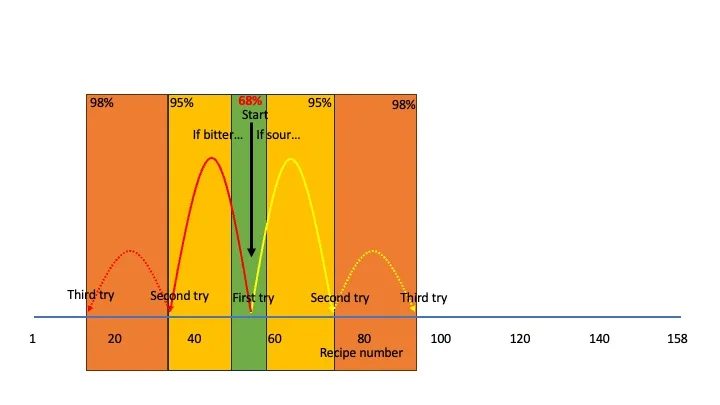Fill in the form
Missed Step 1? see How to measure density
There are two ways of using the series of 158 recipes on this site.
The idea is, when you taste the coffee:
– if the coffee is sour, you extract quite a bit more by next trying a recipe 20 places up the series.
– if the coffee is bitter, you extract quite a bit less by next trying a recipe 20 places down the series.
So either:
1. If you don’t have a measuring cylinder and scales and can’t measure your coffee beans’ density, use the default median starting recipe of 400 (0.400g/ml recipe #80).
68% of the roasted coffee on the planet falls within three tries in either direction. The remaining 30% of coffees may take up to 5 attempts with this method. But at least you can try the recipes with no extra gear. You don’t have to make them all in one go; just mentally note the result and what you want to try next time.

2. The second way is to get yourself a measuring cylinder (you should already have digital scales) and measure the density your bag of coffee beans. A cylinder is cheap, and the process takes less than a minute per bag.

In this example, your measured density is 0.377 g/ml. Entering 377 in the form above gives you a starting recipe of #57.
There is a 68% probability that this recipe will be correct the first time because it is based on a density measurement of your beans.
Chances are it still could be off 30% of the time, but you will already be in the right ballpark, so 95% of the time, you will only need a single recipe change, either up or down.
Method 2 can be up to 5 times faster than method 1. This is a huge return on investment for a tool that is cheap and quick to use. Method 2 has the added benefit of your measurements further improving the density.coffee model. The more measurements entered, the more accurate the model gets, making better recipes.
The huge advantage of the series of recipes is that they help you fully utilise all your extraction tools to their fullest capacity – without having years of barista training. And you always end up with a coffee that tastes the best, the least sour and the least bitter. The best recipe for your coffee. A revelation.
If you start measuring your own density, the system is super-fast to find the best recipe.
DAE, it’s a revolution in making coffee.